Microphysical Characteristics of Convective and Stratiform Precipitation Generated at Different Life Stages of Precipitating Cloud in the Pre-Summer Rainy Season in South China
Abstract
:1. Introduction
2. Materials and Methods
2.1. GPM DPR
2.2. Himawari-8 AHI Data
2.3. Identifying the Life Stage of Precipitating Cloud
- (a)
- When k < −0.3, the PC is considered to be in the developing stage.
- (b)
- When −0.2 < k < 0.2, the PC is considered to be in the mature stage.
- (c)
- When k > 0.3, the PC is considered to be in the dissipating stage.
2.4. Probability Density Function and Vertical Frequency Distribution
3. Results
3.1. Particle Radius Structure and Specific Precipitation Microphysical Properties During Stages
3.2. Vertical Distribution of Radar Reflectivity and Particle Spectrum
3.3. High Precipitation Efficiency and Positive Correlation Between Particle Radius and Storm Top Height
4. Discussion
5. Conclusions
Author Contributions
Funding
Data Availability Statement
Acknowledgments
Conflicts of Interest
References
- Geerts, B.; Teferi, D. Regional and Diurnal Variability of the Vertical Structure of Precipitation Systems in Africa Based on Spaceborne Radar Data. J. Clim. 2005, 18, 893–916. [Google Scholar]
- Saikranthi, K.; Rao, T.N.; Radhakrishna, B.; Rao, S.V.B. Morphology of the Vertical Structure of Precipitation over India and Adjoining Oceans Based on Long-Term Measurements of Trmm Pr. J. Geophys. Res. Atmos. 2014, 119, 8433–8449. [Google Scholar]
- Wu, D.; Dong, X.; Xi, B.; Feng, Z.; Kennedy, A.; Mullendore, G.; Gilmore, M.; Tao, W.-K. Impacts of Microphysical Scheme on Convective and Stratiform Characteristics in Two High Precipitation Squall Line Events. J. Geophys. Res. Atmos. 2013, 118, 11119–11135. [Google Scholar]
- Huang, H.; Chen, F. Precipitation Microphysics of Tropical Cyclones over the Western North Pacific Based on Gpm Dpr Observations: A Preliminary Analysis. J. Geophys. Res. Atmos. 2019, 124, 3124–3142. [Google Scholar] [CrossRef]
- Sun, G.; Li, Y.; Li, S. The Differences in Cloud Vertical Structures between Active and Break Spells of the East Asian Summer Monsoon Based on Cloudsat Data. Atmos. Res. 2019, 224, 157–167. [Google Scholar]
- Xu, J.; Ping, F.; Li, J.Y.; Du, H. A Study of Cloud Microphysical Processes and a Mesoscale Environment in a Heavy Rainfall Case over Yan’an. Front. Earth Sci. 2023, 11, 1149856. [Google Scholar]
- Yin, J.; Gu, H.; Yu, M.; Bao, X.; Xie, Y.; Liang, X. Synergetic Roles of Dynamic and Cloud Microphysical Processes in Extreme Short-Term Rainfall: A Case-Study. Q. J. R. Meteorol. Soc. 2022, 148, 3660–3676. [Google Scholar]
- Guilloteau, C.; Foufoula-Georgiou, E. Life Cycle of Precipitating Cloud Systems from Synergistic Satellite Observations: Evolution of Macrophysical Properties and Precipitation Statistics from Geostationary Cloud Tracking and Gpm Active and Passive Microwave Measurements. J. Hydrometeorol. 2024, 25, 789–805. [Google Scholar]
- Fiolleau, T.; Roca, R. An Algorithm for the Detection and Tracking of Tropical Mesoscale Convective Systems Using Infrared Images from Geostationary Satellite. IEEE Trans. Geosci. Remote Sens. 2013, 51, 4302–4315. [Google Scholar]
- Witte, M.K.; Chuang, P.Y.; Feingold, G. On Clocks and Clouds. Atmos. Chem. Phys. 2014, 14, 6729–6738. [Google Scholar]
- Xiang, J.; Wang, H.; Li, Z.; Bu, Z.; Yang, R.; Liu, Z. Case Study on the Evolution and Precipitation Characteristics of Southwest Vortex in China: Insights from Fy-4a and Gpm Observations. Remote Sens. 2023, 15, 4114. [Google Scholar] [CrossRef]
- Fu, Y.; Zhang, A. Life Cycle Effects on the Vertical Structure of Precipitation in East China Measured by Himawari-8 and Gpm Dpr. Mon. Weather Rev. 2018, 146, 2183–2199. [Google Scholar]
- Kumar, S.; Del Castillo-Velarde, C.; Rojas, J.L.F.; Moya-Álvarez, A.; Castro, D.M.; Srivastava, S.; Silva, Y. Precipitation Structure During Various Phases the Life Cycle of Precipitating Cloud Systems Using Geostationary Satellite and Space-Based Precipitation Radar over Peru. GIScience Remote Sens. 2020, 57, 1057–1082. [Google Scholar]
- Sun, Y.; Dong, X.; Cui, W.; Zhou, Z.; Fu, Z.; Zhou, L.; Deng, Y.; Cui, C. Vertical Structures of Typical Meiyu Precipitation Events Retrieved from Gpm-Dpr. J. Geophys. Res. Atmos. 2020, 125, e2019JD031466. [Google Scholar]
- Wan, Q.; Wang, B.; Wong, W.K.; Hu, Z.; Jou, B.J.-D.; Lin, Y.; Johnson, R.H.; Chang, C.-P.; Zhu, Y.; Zhang, X.; et al. The Southern China Monsoon Rainfall Experiment (Scmrex). Bull. Am. Meteorol. Soc. 2017, 98, 999–1013. [Google Scholar] [CrossRef]
- He, J.; Zheng, J.; Zeng, Z.; Che, Y.; Zheng, M.; Li, J. A Comparative Study on the Vertical Structures and Microphysical Properties of Stratiform Precipitation over South China and the Tibetan Plateau. Remote Sens. 2021, 13, 2897. [Google Scholar] [CrossRef]
- Zhang, A.; Chen, Y.; Li, W.; Chen, S. Event-Based Precipitation Characteristics Related to Cloud-Top Temperature During Pre-Summer Rainy Season over South China. Int. J. Climatol. 2023, 43, 2271–2286. [Google Scholar] [CrossRef]
- Hou, A.Y.; Kakar, R.K.; Neeck, S.; Azarbarzin, A.A.; Kummerow, C.D.; Kojima, M.; Oki, R.; Nakamura, K.; Iguchi, T. The Global Precipitation Measurement Mission. Bull. Am. Meteorol. Soc. 2014, 95, 701–722. [Google Scholar] [CrossRef]
- Hu, X.; Ai, W.; Qiao, J.; Hu, S.; Han, D.; Yan, W. Microphysics of Summer Precipitation over Yangtze-Huai River Valley Region in China Revealed by Gpm Dpr Observation. Earth Space Sci. 2022, 9, e2021EA002021. [Google Scholar]
- Ryu, J.; Song, H.-J.; Sohn, B.-J.; Liu, C. Global Distribution of Three Types of Drop Size Distribution Representing Heavy Rainfall from Gpm/Dpr Measurements. Geophys. Res. Lett. 2021, 48, e2020GL090871. [Google Scholar]
- Wen, L.; Chen, G.; Yang, C.; Zhang, H.; Fu, Z. Seasonal Variations in Precipitation Microphysics over East China Based on Gpm Dpr Observations. Atmos. Res. 2023, 293, 106933. [Google Scholar]
- Gao, J.; Tang, G.; Hong, Y. Similarities and Improvements of Gpm Dual-Frequency Precipitation Radar (Dpr) Upon Trmm Precipitation Radar (Pr) in Global Precipitation Rate Estimation, Type Classification and Vertical Profiling. Remote Sens. 2017, 9, 1142. [Google Scholar] [CrossRef]
- Houze, R.A.; Wilton, D.C.; Smull, B.F. Monsoon Convection in the Himalayan Region as Seen by the Trmm Precipitation Radar. Q. J. R. Meteorol. Soc. 2007, 133, 1389–1411. [Google Scholar]
- Liu, C.; Zipser, E.J. The Global Distribution of Largest, Deepest, and Most Intense Precipitation Systems. Geophys. Res. Lett. 2015, 42, 3591–3595. [Google Scholar]
- Di, D.; Li, J.; Xue, Y.; Min, M.; Li, B.; Li, Z. Consistency of Tropospheric Water Vapor between Reanalyses and Himawari-8/Ahi Measurements over East Asia. Adv. Atmos. Sci. 2023, 41, 19–38. [Google Scholar]
- Yang, C.; Guan, L.; Sun, X. Comparison of Fy-4a/Agri Sst with Himawari-8/Ahi and in Situ Sst. Remote Sens. 2023, 15, 4139. [Google Scholar] [CrossRef]
- Bringi, V.N.; Chandrasekar, V.; Hubbert, J. Raindrop Size Distribution in Different Climatic Regimes from Disdrometer and Dual-Polarized Radar Analysis. Am. Meteorol. Soc. 2003, 60, 354–365. [Google Scholar]


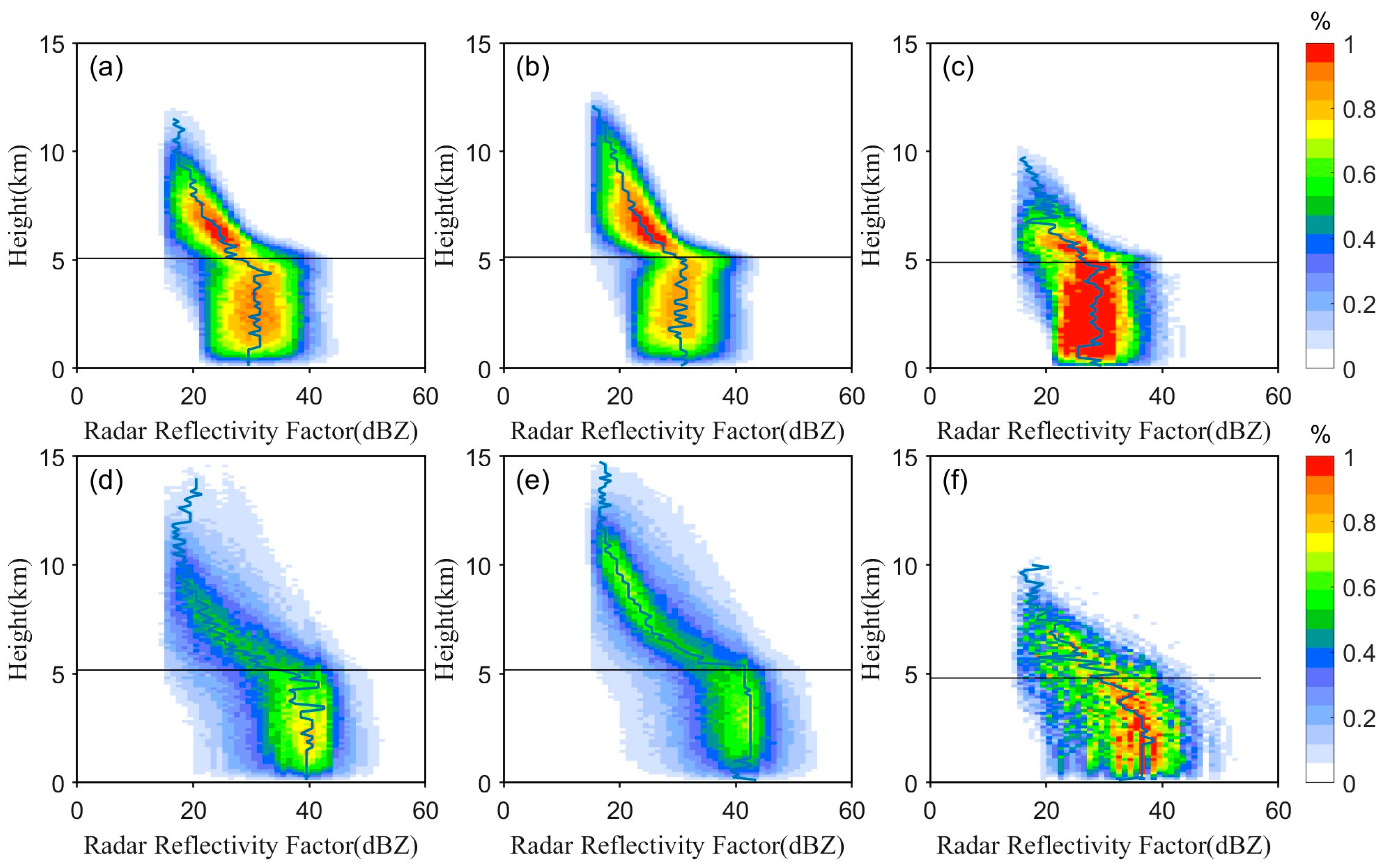
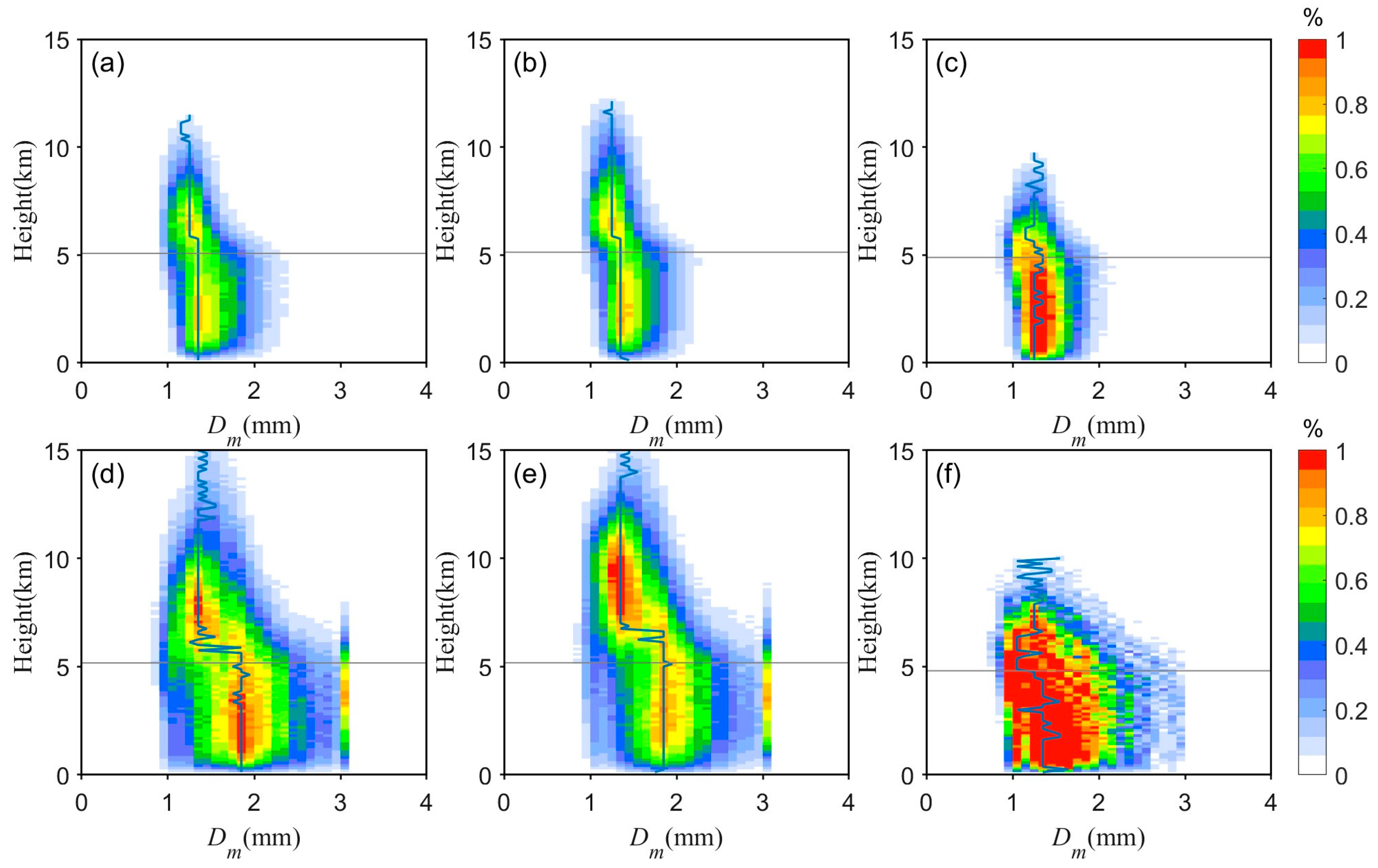
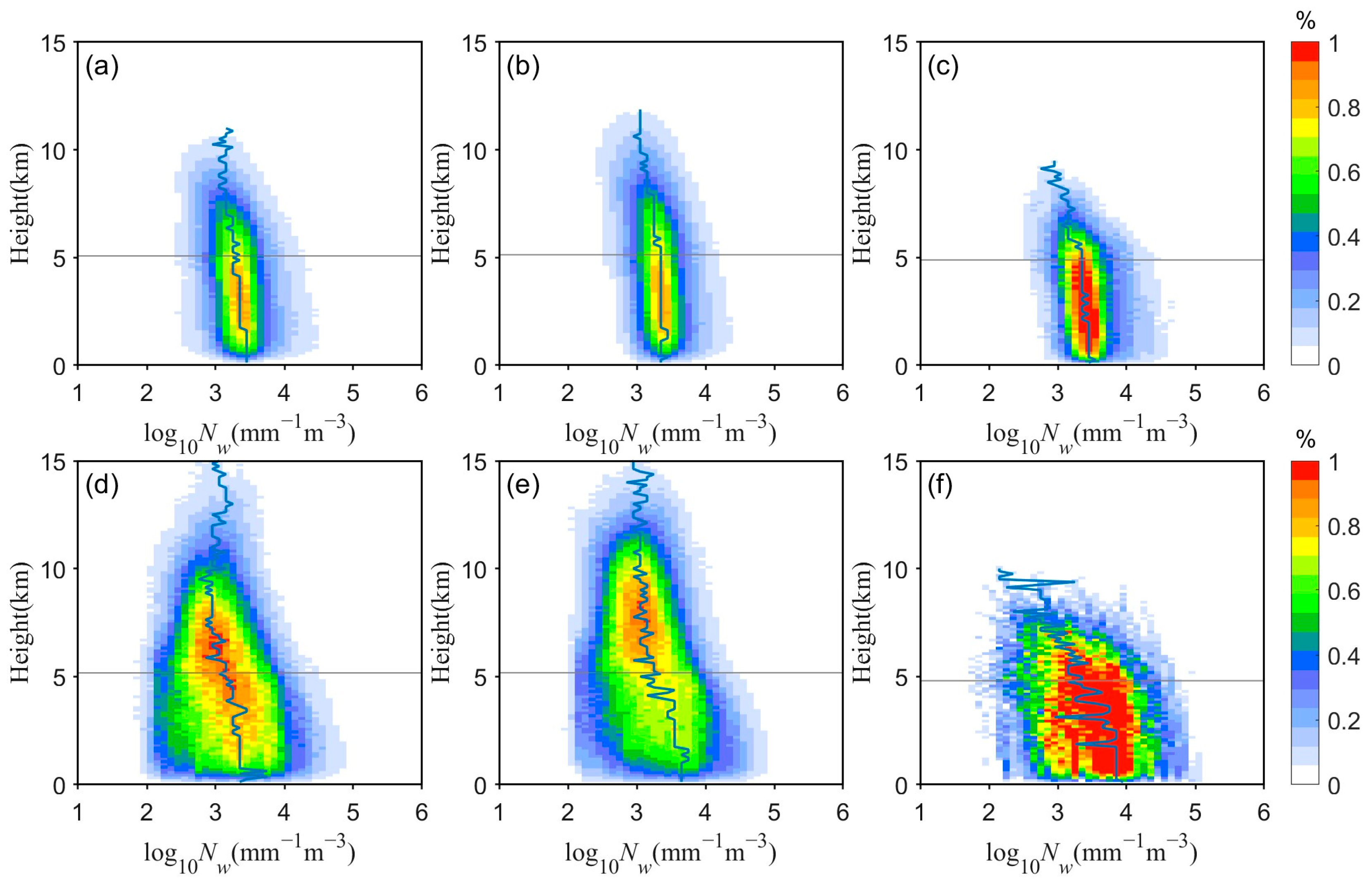
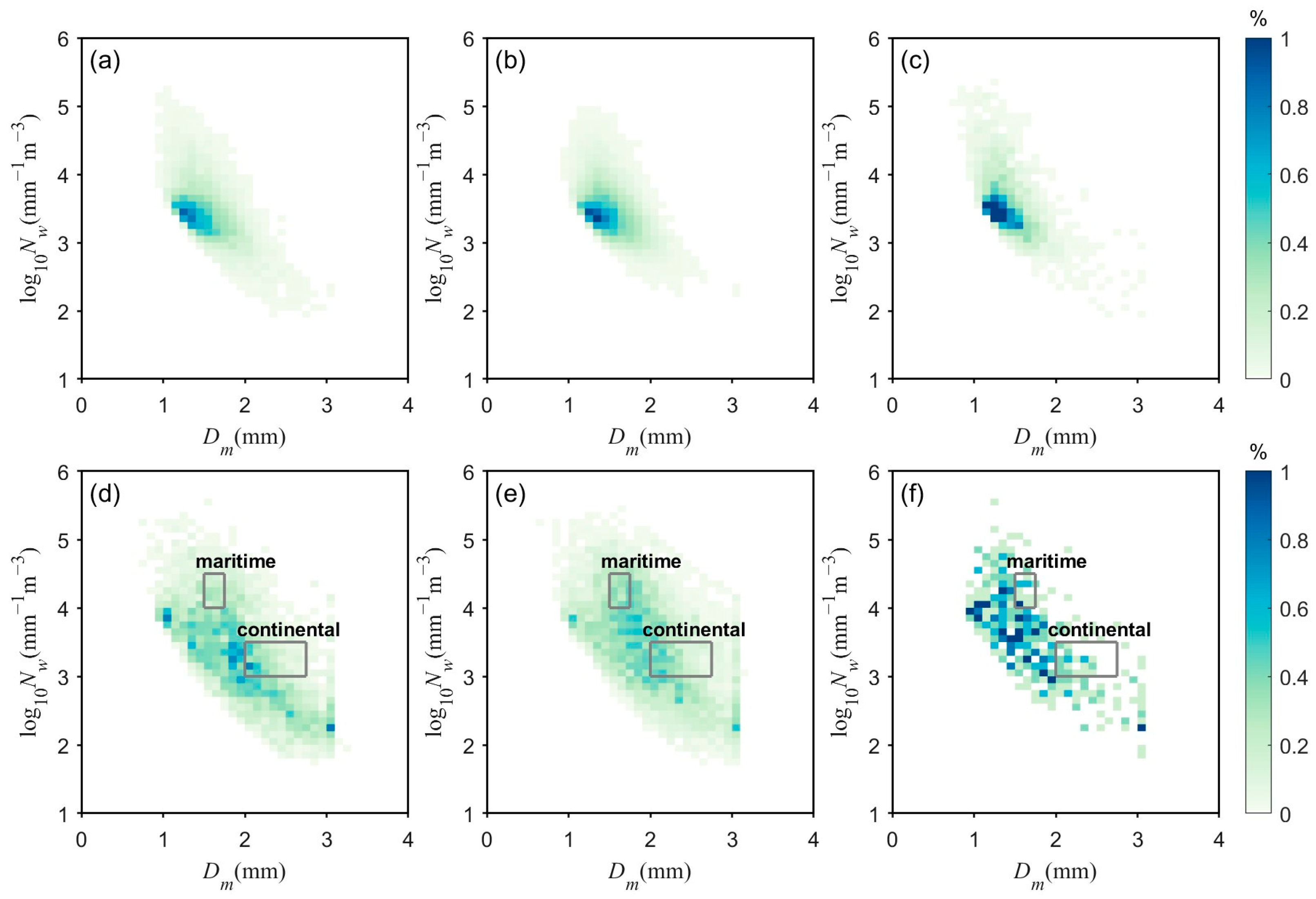

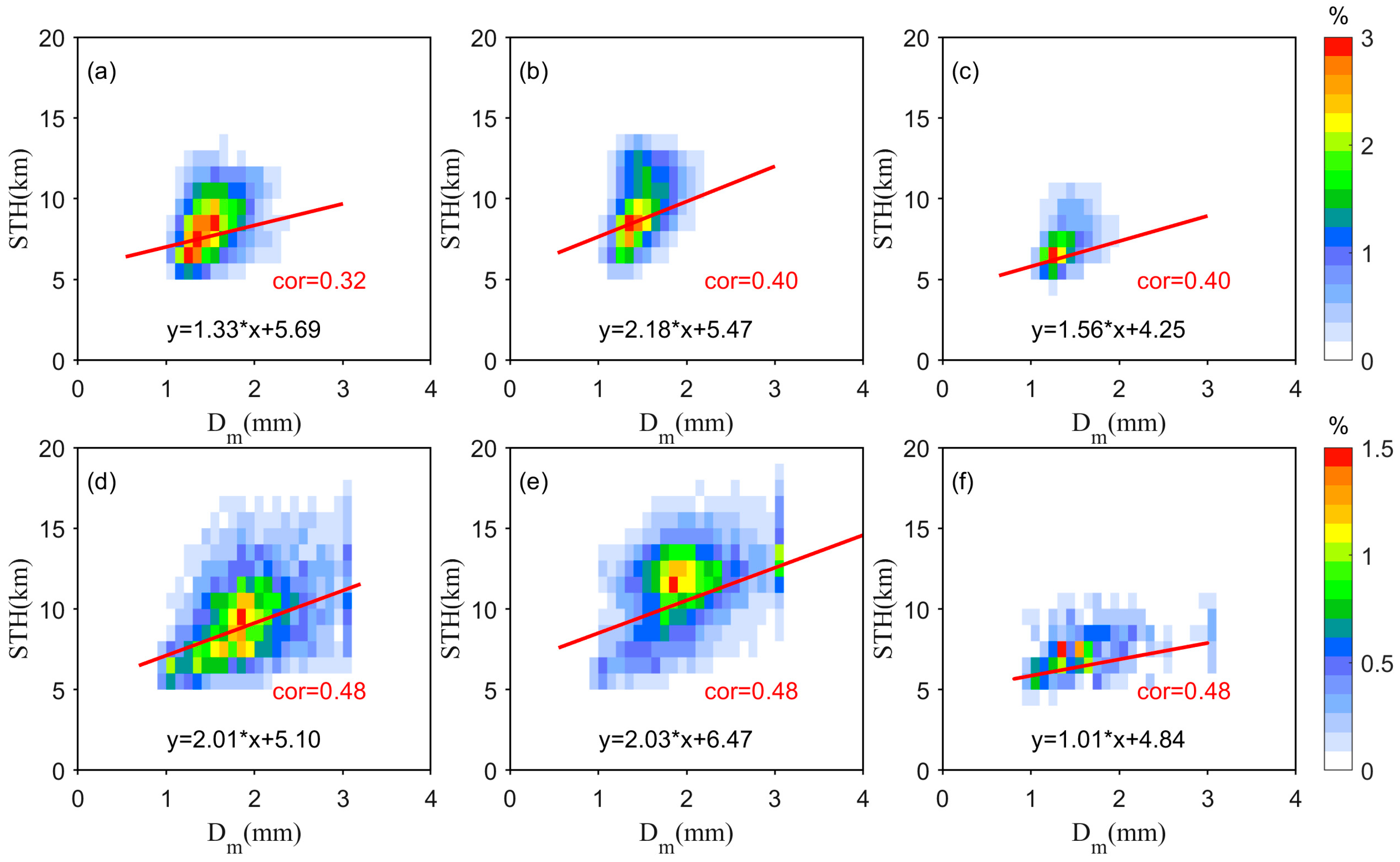
| Life Stage | Developing | Mature | Dissipating |
|---|---|---|---|
| Amount of rain cells | 101 | 87 | 20 |
| Convective precipitation ratio | 28.4% | 20.6% | 13.9% |
| Stratiform precipitation ratio | 63.9% | 76.6% | 78.5% |
| Average LWP (g·m−2) | 888.04 | 978.61 | 642.89 |
| Average IWP (g·m−2) | 347.72 | 493.69 | 176.03 |
| Maximum precipitation area (km2) | 46,375 | 111,325 | 11,650 |
| Average precipitation area (km2) | 5378 | 15,443 | 4415 |
Disclaimer/Publisher’s Note: The statements, opinions and data contained in all publications are solely those of the individual author(s) and contributor(s) and not of MDPI and/or the editor(s). MDPI and/or the editor(s) disclaim responsibility for any injury to people or property resulting from any ideas, methods, instructions or products referred to in the content. |
© 2025 by the authors. Licensee MDPI, Basel, Switzerland. This article is an open access article distributed under the terms and conditions of the Creative Commons Attribution (CC BY) license (https://creativecommons.org/licenses/by/4.0/).
Share and Cite
Yang, J.; Li, Y.; Hu, X.; Zhang, Z.; Kou, X. Microphysical Characteristics of Convective and Stratiform Precipitation Generated at Different Life Stages of Precipitating Cloud in the Pre-Summer Rainy Season in South China. Remote Sens. 2025, 17, 1250. https://doi.org/10.3390/rs17071250
Yang J, Li Y, Hu X, Zhang Z, Kou X. Microphysical Characteristics of Convective and Stratiform Precipitation Generated at Different Life Stages of Precipitating Cloud in the Pre-Summer Rainy Season in South China. Remote Sensing. 2025; 17(7):1250. https://doi.org/10.3390/rs17071250
Chicago/Turabian StyleYang, Jiayan, Yunying Li, Xiong Hu, Zhiwei Zhang, and Xiongwei Kou. 2025. "Microphysical Characteristics of Convective and Stratiform Precipitation Generated at Different Life Stages of Precipitating Cloud in the Pre-Summer Rainy Season in South China" Remote Sensing 17, no. 7: 1250. https://doi.org/10.3390/rs17071250
APA StyleYang, J., Li, Y., Hu, X., Zhang, Z., & Kou, X. (2025). Microphysical Characteristics of Convective and Stratiform Precipitation Generated at Different Life Stages of Precipitating Cloud in the Pre-Summer Rainy Season in South China. Remote Sensing, 17(7), 1250. https://doi.org/10.3390/rs17071250







